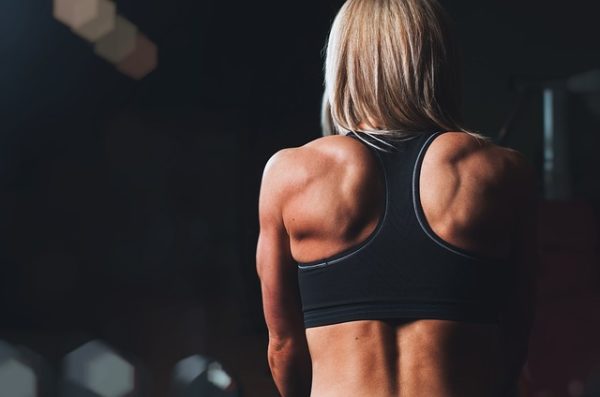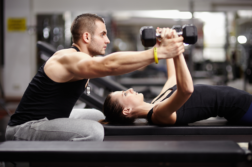
Image via Pexels
Have you ever thought of including split squats in your exercise routine? They are perfect for strong glutes, quads, and hamstrings and can provide you with an incredible toning workout. One of the best squat exercises is the Bulgarian split squat. It is a highly effective squat exercise that many find difficult to do but will give you incredible results. You can do 10 bodyweight Bulgarian split squats and hardly be able to sit on the toilet the next day. So what is the Bulgarian split squat?
No products found.
What Is the Bulgarian Split Squat?

Image via Pexels
The Bulgarian split squat is a single leg exercise that mainly targets your glutes, hamstrings, and quads. There are three key parts of doing the exercise. You balance on one foot while placing the other on a box or bench. Your back stays straight throughout the entire workout process. You hold dumbbells to add weight instead of using barbells.
There are several variations of the Bulgarian split squat you can do. These include the goblet and the barbell Bulgarian split squats. No one knows who created the exercise, but it was popularized by the Bulgarian Olympic weightlifting coach named Angel Spassov. Olympic weightlifters should have lower body strength and including these squats helps them achieve this.
Targeted Muscles
The Bulgarian split squat is one of the best exercises to work out your major muscle groups. It emphasizes the quadriceps, a muscle group on the front of your thighs, which include the rectus femoris, vastus lateralis, vastus medialis, and vastus intermedius. Like all other compound exercises, it also targets other body parts and muscle groups, which include the hamstrings, erector spinae, glutes, calves, and forearms.
From these targeted areas, it works out the entire anterior and posterior muscles in your legs. The move does not mess around and it is one reason many athletes find it difficult to adopt in their training routines.
Why Bulgarian Squats Are Awesome
Besides the fact that your butt will feel the burn almost instantly when you do the exercise, the following are additional benefits of including the exercise in your routine.
- The squats are unilateral
- Strengthens stabilizer muscles
- Do not take a lot of weight or a spotter
- Easy to learn
Since the squats are unilateral, each leg is worked out independently. One leg is focused on at a time and there is no risk of overcompensation. You work your left side as hard as your right. It is the perfect exercise for building strength and can also help you recover from an injury. By allowing you to strengthen the stabilizer muscles, you will be stronger and healthier. Balance is an aspect of training that many athletes do not focus on but it is important for maintaining mobility and keeping healthy.
You do not have to use a lot of weight or a spotter. If you do squats and deadlifts, you may need a spotter to help you run out the weights. This is expensive. Bulgarian squats will activate the toning of muscles while needing just a little additional weight. You do not need a spotter unless you want someone to hand you the dumbbell once you get into position.
Bulgarian squats are easy to learn. In fact, they are one of the easiest exercises to learn. Some people may find the exercise difficult to master due to range-of-motion issues or limiting factors in their backs. However, most people can master it since it is not a heavy or weight-bearing move.
The squats are universally doable, especially for people with oddly shaped femurs, and they are arguably injury proof. The exercise is easier to learn than the full-on back squat. It is better than the back squat since it focuses on your lower back, which limits the weight you can lift at a go. In the Bulgarian split squats, you will focus on your glutes, hamstrings, and quads altogether, which works out the major muscles in the anterior and posterior body.
How to Do a Proper Bulgarian Split Squat
There are two ways of doing the Bulgarian split squat. You set up to do the exercise with a regular bench, a riser or a few plates. Note that placing your weight on a regular bench can make the exercise difficult due to trying to balance while holding heavy dumbbells. This increases the risk of injury and reduces the practicality and effectiveness of the exercise. If you find it difficult to achieve a balanced position, you can use a few plates which you can find in your gym.
The trickiest part is figuring out where to put your front foot. However, you can adopt a narrow or a more stretched out stance, whichever you feel comfortable with. In particular, ensure you feel most of the weight on your forward leg and ensure that you don’t feel pain or excessive tightness around your knee, lower back, and glutes. Note that this may take some trial and error, but the easiest way of finding your comfortable spot is by doing some warm-up sets with no weights and trying different foot positions.

Image via Pexels
Instructions
- 1Find a step, raised plates, a bench, or any other contraption you can rest your foot on – the height should be about your knee’s height
- 2Get into a forward lunge position ensuring your torso is upright, core braced, hips square, and back foot elevated on the bench
- 3Lower until your front thigh is almost horizontal, keeping your knee in line with your foot – do not let your front knee travel past your toes
- 4Make sure your leading leg is half a meter or so in front of the bench
- 5Drive up through your front heel to the starting position while keeping your movements measured
You need to repeat these five steps about 5-10 times then swap to the other leg.
Tips
Make sure you get your distance right. When you stand too close to the bench, you will put more emphasis on your quads, but make sure you are not too close as it might cause knee pain. When you stand further away, you will work your hip flexors more, but it could also strain your groin. It is best if you experiment to find the perfect distance from the bench.
Aside from experimenting on the distance, you also need to experiment on your weight. There is a myriad of ways of holding weight when doing the exercise. The simplest is the goblet which entails holding a dumbbell upright in front of you. Once you have maxed out the dumbbells, you can switch to holding a dumbbell in each hand and use straps if necessary.
Bulgarian Split Squat Variations

Image via Pixabay
First, there is the gym ball Bulgarian squat. One of the key challenges of doing an elevated squat is maintaining your balance. You can make it harder by resting your back foot on a gym ball. The surface instability demands more from your core and front legs to do the exercise smoothly.
Second, the dumbbell Bulgarian squats are done by adding dumbbells to the exercise. It is an easier option than the barbell. You need to hold a dumbbell in each hand as you perform the squat.
Third, there is the gym ball Bulgarian split squat accompanied by a twist. You can ditch your weights in this variation. It adds another plane of movement to test your coordination and balance. Here, you hold your arms out in front with your hands together and then twist your torso to one side as you lower into the squat.
Conclusion
The Bulgarian split squat is an easy-to-learn but difficult-to-perform exercise to include in your training routine. It is a single leg exercise that targets your glutes, hamstrings, and quads. You do the exercise by balancing on one foot and placing the other on a box or bench. Your back stays straight and you can hold dumbbells to add weight. The Bulgarian split squat is one of the best exercises to work out your major muscle groups it emphasizes the quadriceps. You should try the exercise as it is unilateral, strengthens stabilizer muscles, and you do not need a lot of weight or a spotter. You can learn it easily.
You can use a regular bench, a riser, or a few plates to hold one leg into position while balancing on the other. It is tricky to figure out where to put your front foot but you can adopt a narrow or a more stretched out stance, whichever you feel comfortable with. This takes trial and error, but you can find the most convenient position by doing the squats at first without weights. You also need to experiment on your weight.
You can hold weights in a variety of ways but the simplest is the goblet which entails holding a dumbbell upright in front of you. The Bulgarian split squat has three variations. You can do it with a gym ball, a dumbbell, or a gym ball with a twist. You can try these variations depending on your preference. We hope that this article has adequately addressed what the Bulgarian split squat is, and how to do it properly.
Last update on 2024-06-20 at 22:05 / Affiliate links / Images from Amazon Product Advertising API



